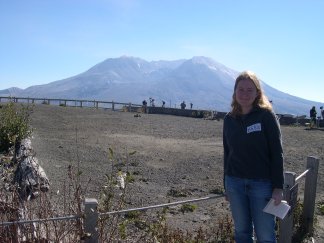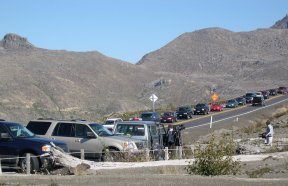News Detective: Observing a Volcano

Kate waits for a volcano to erupt.
If you thought that a volcano near your house was about to erupt, what would you do? If you’re like me and hundreds of other residents of the Pacific Northwest, you’d pack a picnic lunch and try to find the best viewing spot!
On Oct. 2, the day after Mount St. Helens belched a little steam and ash for the first time in a long while, I drove out to the Johnston Ridge Observatory at the Mount St. Helens National Volcanic Monument. It’s the closest visitor’s center to the volcano. Scientists were saying that it was very possible that the volcano would erupt again, so I was hoping to have a front row seat.
I was definitely not the only one with that idea. The parking lot, which holds more than 350 cars, was almost full. People were lining up along the rails of the overlook, cameras set up on tripods, pointed at the mountain, so that they would be ready if the volcano blew. The visitor’s center was packed with people looking at models of the volcano and watching the needle on the seismograph, which measures earth movement, jerk up and down with the swarms of tiny earthquakes in the crater.
Unfortunately, I got to the observatory about 1 hour after a steam burst had escaped from the mountain, but I was determined to catch the next bit of excitement. As I waited, I talked with one of the park rangers. He said that scientists studying the volcano were about to give a press conference at another lookout down the road. So I hopped back in my car and joined TV news crews and newspaper reporters from around the country to hear the latest updates.
I was at the media gathering place for only half an hour when we noticed a long stream of cars going back down the mountain. The U.S. Forest Service had closed the observatory because rangers thought that an eruption could happen at any moment. So everyone had to retreat to another visitor’s center farther away from Mount St. Helens.
 |
| A long row of cars streams away from the Johnston Ridge Observatory in case Mount St. Helens erupts. |
| Kate Ramsayer |
The only thing that would have made it more exciting would have been if the volcano had actually erupted! Unfortunately for me, even though I waited until it got dark that Saturday and then came back on Sunday, the only movement I saw on the volcano was some rockslides.
Still, it was a beautiful fall weekend, and I got to spend it outside, meeting people and talking with other reporters, sharing guesses about when, or if, the volcano would erupt. We were all afraid to leave, because we were sure that something would happen just as soon as we got out of sight.
“Everybody’s really excited and wants to see anything, but unfortunately I can’t push the button,” says Alison Eckberg. She’s a park ranger at the Coldwater Ridge Visitors Center, which filled up when the Johnston Ridge Observatory was closed.
“I’d like to see it explode, to see some kind of action. That would be amazing,” 15-year-old Nicki Tarr says. She lives in Tigard, Ore., and had come to watch the volcano with her family. The Tarrs had good seats at an overlook, but hundreds of other people simply parked along the road and pointed their folding chairs towards the mountain.
Families and friends brought Frisbees, footballs, books, and barbeques to pass the time. Although there was only that little steam burst on Saturday morning, nobody I talked to wished that they had stayed home that weekend.
“You couldn’t ask for a better day to stand and watch a volcano,” says Paul McKerracher, who was at the Coldwater Ridge Observatory.
I agreed.—K. Ramsayer